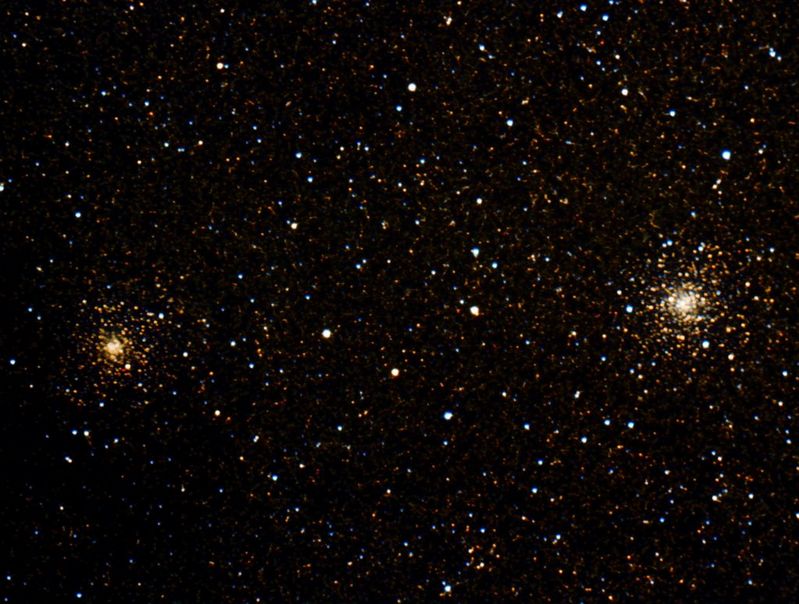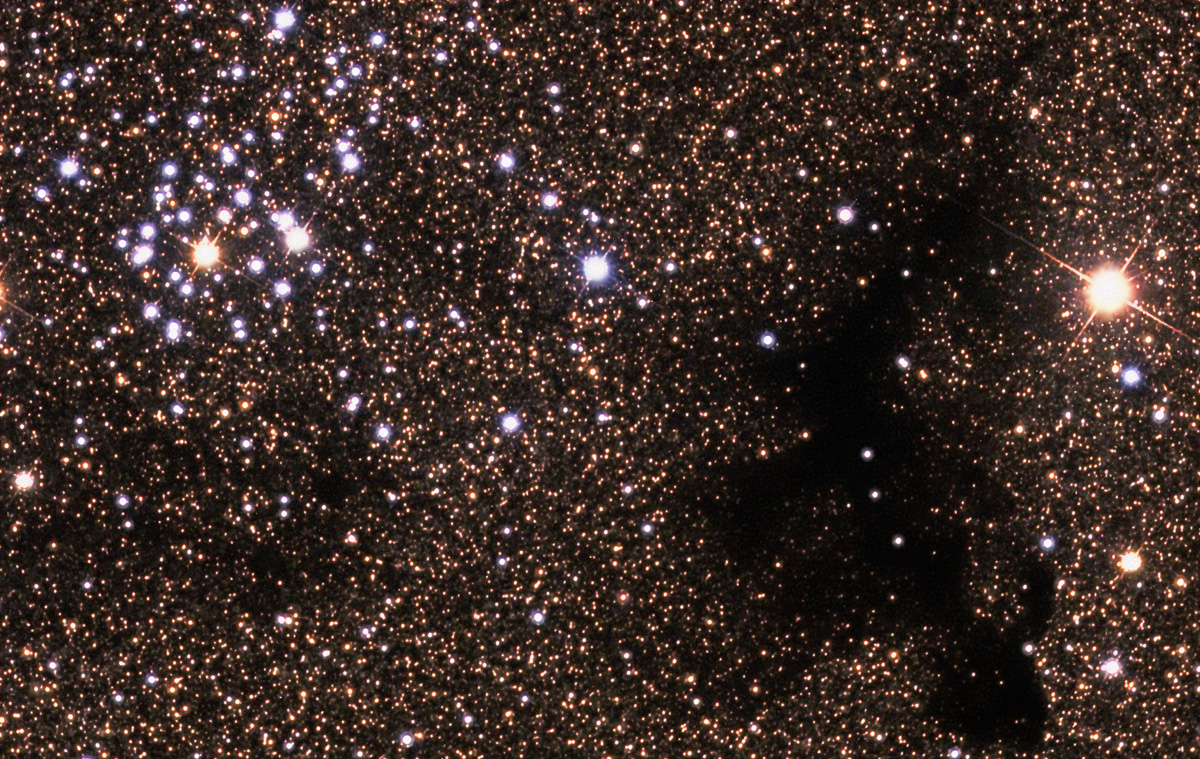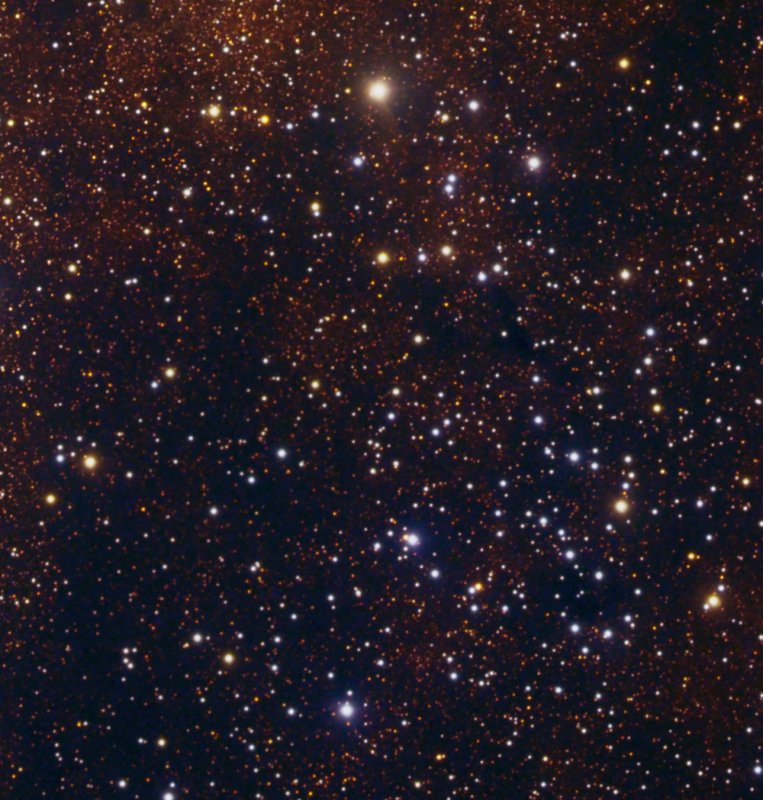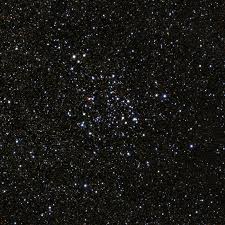STARLOG
ARROWS FROM THE ARCHER
JULY 14, 2017
| Observer: |
Tom Campbell |
| Location: |
College Station, Texas (Long: 96°17'W Lat: 30°37'N) |
| Telescope: |
Zhumell 12" f/5 Dobsonian |
| Eyepieces: |
Explore Scientific 18mm (83x)
Explore Scientific 11mm (136x) |
| Lenses: |
Celestron Luminos Barlow (2.5x) |
It was a dark and stormy night. Not the most promising way to begin an observing report, I know. But luckily, that was the end of the evening. At sunset, the sky was still mostly clear, so that's where I will start.
We've had several days in a row of almost unbearably hot weather. Upper 90s to low 100s, with high humidity. A typical central Texas summer, from what I've been told.
The good news is that it's even too hot for most of the bugs and even the dew is smart enough to go somewhere cooler to bed down for the night. The bad news is that the humidity is prone to forming clouds.
With few exceptions, that's been the forecast for the last month or so. Partly cloudy skies that let the Sun peek through enough to make the days miserable, but intermittent enough that I don't want to bother setting up the scopes for solar viewing.
And don't get me started on the nights. Enough stars are visible to make me yearn to set up my telescope, but deep down I know the air is thick enough to cut with a knife. There's no way I'd be satisfied with the views of whatever I was looking at.
But once in a while, the clouds get bored with doing the same thing day after day and night after night. Like most of us, they want a change. So they go run off to visit some other place with more atmosphere, so to speak. At least for a few hours before they remember about my telescope and come running back to frustrate me again.
Tonight was one of those nights. At sunset, most of the day's clouds had wandered off in search of greener or cooler pastures. I took advantage of the situation and decided to haul out the telescope for a bit in the hopes of seeing a few new targets and revisiting some old friends. The summer Milky Way constellations are among my favorites and I was happy to get a chance to see them again.
I've recently become rather fond of just picking a constellation and then poring over my star charts to see how many different objects I can find. It means I'm keeping the telescope in the same general area of sky all night, and only need to fumble around with a few pages of charts out there in the dark. Scanning the sky, my eyes settled on Sagittarius, the Archer. The "teapot" portion of the constellation was positioned nicely in the southern sky, about as high as it was going to get from this latitude.
| NGC 6528 |
Sagittarius |
Globular Cluster |
10:35pm CDT |
 |
This cluster is small and compact, and somewhat faint. I was not able to resolve individual stars, even with averted vision. The best view was with the barlowed 18mm (208x). It was round, with a brighter core which quickly faded towards the outer edges. |
| |
| NGC 6522 |
Sagittarius |
Globular Cluster |
10:40pm CDT |
 |
I had a lot of trouble with this one. It looked very stellar and I wasn't able to detect any nebulosity or signs that it was a globular cluster. It did serve well to help me make sure my eyepiece was focused properly when viewing nearby NGC 6528. |
| |
| NGC 6520 |
Sagittarius |
Open Cluster |
10:50pm CDT |
 |
Using the barlowed 18mm (208x), this appeared as a nice, rich open cluster. There were a few bright members, with the brightest being a yellowish-orange star right in the center. Fainter members circled around this star in the cluster. The brightest members formed a somewhat trapezoid shape along the outer edges. A dark nebula is supposed to run through it, but I couldn't detect it. |
| |
| NGC 6425 |
Scorpius |
Open Cluster |
11:00pm CDT |
 |
This open cluster is near M6, and has 15-20 fairly faint stars. The cluster is somewhat loose and reminds me of a bug face. Several stars make an ovoid face, with 2 arcs of stars forming the antennae. |
| |
| NGC 6416 |
Scorpius |
Open Cluster |
11:05pm CDT |
 |
This cluster is also close to M6. With the 18mm (83x), it appears loose and somewhat fish-shaped. The brightest star is at the mouth of the fish, with most of the other bright stars being near the tail. A little W shape of stars forms the gills. About 20-30 stars make up the cluster, which fills the field. |
| |
I saw a bright flash of light out of the corner of my eye, so I looked up. Lightning was flashing on the horizon. The sky was still mostly clear, but I could see some clouds gathering in the east. Whatever those clouds had found to do, it looked like they were having a wild time. I better pick up my pace a bit.
| NGC 6451 |
Sagittarius |
Open Cluster |
11:10pm CDT |
 |
This is a really nice open cluster. It is compact, with about 20 stars altogether. It has an odd shape with several stars forming small scalloped s-shaped arcs. It is known as the Tom Thumb cluster, and I suppose I can make out a hitchhiker's thumb if I use enough imagination. |
| |
| Cr 394 |
Sagittarius |
Open Cluster |
11:20pm CDT |
 |
This cluster is shaped like a wide triangle. Below the base of the triangle is a wide pair of bright stars. The apex of the triangle has another pair of stars. |
| |
| M 22 |
Sagittarius |
Globular Cluster |
11:30pm CDT |
 |
This is a very nice globular cluster. Even with my 18mm (83x), stars were resolved across the entire cluster with a hazy patch in the background. |
| |
| NGC 6642 |
Sagittarius |
Globular Cluster |
11:35pm CDT |
 |
The best view was with the 11mm (136x). The cluster appeared very faint and tiny, almost like a planetary nebula. I could tell it was round and brightest in the center, but could not discern a stellar core. Averted vision makes the nebulosity appear a little larger and there are moments when a couple of stars seem to resolve, but nothing definite. |
| |
| NGC 6629 |
Sagittarius |
Planetary Nebula |
11:40pm CDT |
 |
This planetary is a tiny little guy. Using a barlowed 11mm (341x), I could not really make out any detail. It appeared small, round, fuzzy, and brightest in the center. |
| |
The lightning was still distant, but was getting more frequent, and I could hear the rumblings of thunder on occasion. I decided not to press my luck any longer.
But before putting my gear away, I had to take a peek at Jupiter and Saturn. The seeing wasn't very good in this part of the sky, being over a neighbor's roof. Jupiter shimmered a lot in the eyepiece. Still, I was able to get a decent view with my barlowed 18mm (208x). In moments of good seeing, I could easily make out the Great Red Spot just coming around from the back side. All four of the Galilean moons were visible, and there were also a couple of similarly-bright field stars, making it look like there were six moons tonight.
Saturn, however, was a different story. The seeing was better in this part of the sky, and I was able to use my barlowed 11mm (341x). Several bands of differing shades of yellow and brown were visible on the planet itself, and the rings looked fantastic. The Cassini Division was wide and obvious, and even the purplish wisp of the Crepe Ring was visible all the away around the planet. In moments of great seeing, I thought I could detect hints of the Encke Gap in the A Ring, but it could have been my imagination.
The moon Titan loomed bright and well away from Saturn. Closer in, I could easily spot Dione, Rhea and Tethys, forming a nice triangle around the ringed world. I think Enceladus was visible as well, but to be honest, I wasn't paying much attention to the moons because the planet itself was so glorious.
I could have stared at Saturn for an hour, but another flash of light in the sky reminded me why I had to pack things up.









